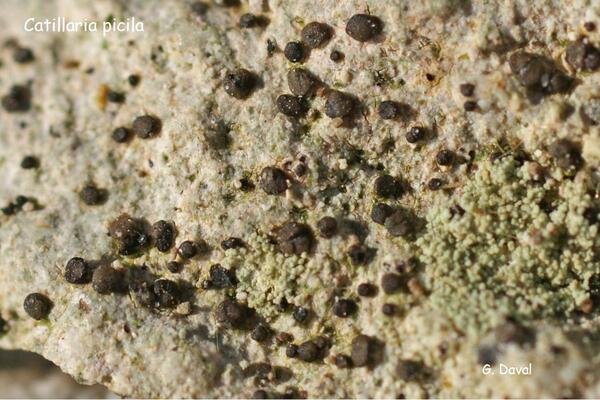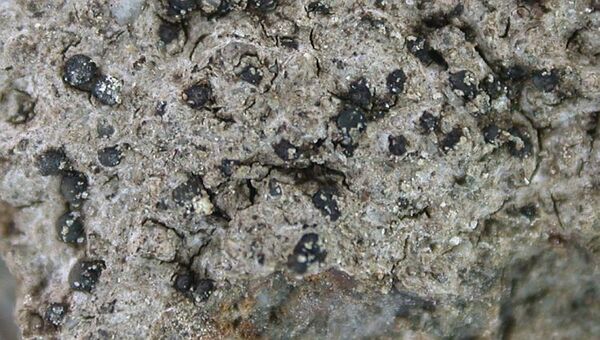Catillaria picila (A. Massal.) Coppins
Lichenologist, 21: 223, 1989. Basionym: Biatora picila A. Massal. - Miscell. Lichenol.: 38, 1856.
Synonyms: Biatorina picila (A. Massal.) Zahlbr.; Catillaria anomaloides auct. non (A. Massal.) Lettau; Lecidea anomaliza Nyl.; Lecidea picila (A. Massal.) Nyl.
Description: Thallus crustose, episubstratic, continuous or finely granulose and composed of small goniocysts, yellowish white to greenish, sometimes poorly evident. Apothecia lecideine, 0.3-0.8 mm across, brown-black to black when dry, brown to red-brown and with a darker margin when wet, at first semi-immersed, then sessile and sometimes slightly constricted at base, with a flat to more or less convex disc, and a blackish, initially raised, finally often excluded proper margin. Proper exciple dark violet-brown, K+ purple-violet, paler or colourless in outer part, of anticlinally arranged, large, thick-walled cells; epithecium colourless to pale brown, without crystals; hymenium colourless, 50-70 µm high; paraphyses simple or sparingly and shortly branched in upper part, coherent, 1.5-2.5(-3) µm thick, the apical cells not markedly swollen; hypothecium dark violet-brown, K+ purple-violet. Asci 8-spored, cylindrical-clavate, surrounded by a gelatinous I+ blue coat, with a well-developed I+ blue tholus, a I+ darker blue tube and a well-developed ocular chamber, approaching the Bacidia-type. Ascospores 0-1-septate, hyaline, oblong-ellipsoid, (8-)9-17(-20) x 3-4.5 µm. Photobiont chlorococcoid, with slightly elongated cells. Spot tests: thallus K-, C-, KC-, P-, UV- Chemistry: unknown, but probably thallus without lichen substances.
Growth form: Crustose
Substrata: rocks
Photobiont: green algae other than Trentepohlia
Reproductive strategy: mainly sexual
Commonnes-rarity: (info)
Alpine belt: absent
Subalpine belt: extremely rare
Montane belt: very rare
Dry submediterranean belt: very rare
Humid submediterranean belt: very rare
Padanian area: absent
pH of the substrata:
1 2 3 4 5
Solar irradiation:
1 2 3 4 5
Aridity:
1 2 3 4 5
Eutrophication:
1 2 3 4 5
Poleotolerance:
0 1 2 3
Altitudinal distribution:
1 2 3 4 5 6
Rarity
absent
extremely rare
very rare
rare
rather rare
rather common
common
very common
extremely common
Loading data...
Occurrence data
Predictive map
Growth form: Crustose
Substrata: rocks
Photobiont: green algae other than Trentepohlia
Reproductive strategy: mainly sexual
Commonnes-rarity: (info)
Alpine belt: absent
Subalpine belt: extremely rare
Montane belt: very rare
Dry submediterranean belt: very rare
Humid submediterranean belt: very rare
Padanian area: absent
pH of the substrata:
| 1 | 2 | 3 | 4 | 5 |
Solar irradiation:
| 1 | 2 | 3 | 4 | 5 |
Aridity:
| 1 | 2 | 3 | 4 | 5 |
Eutrophication:
| 1 | 2 | 3 | 4 | 5 |
Poleotolerance:
| 0 | 1 | 2 | 3 |
Altitudinal distribution:
| 1 | 2 | 3 | 4 | 5 | 6 |
Rarity
absent
extremely rare
very rare
rare
rather rare
rather common
common
very common
extremely common
Loading data...
Occurrence data
Predictive map








